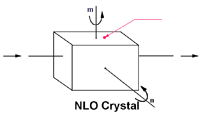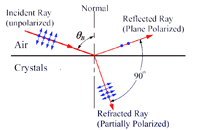 |
|
||||||
 |
How to choice NLO Crystals |
| Home > Knowledge Center > Applications |
Angle Tilting Optimum Crystal Size and Cut When ordering a nonlinear optical crystal, crystal orientation (or crystal cut) and size have to be known. The orientation is solely determined by the nonlinear optical process. For example, for type I frequency-doubling of 1.064mm, BBO is cut at q = 22.8° and f = 0°. Where:q is the polar angle between the optical axis and the propagation direction, f is the azimuthal angle between the projection of propagation direction onto the XY plane and the X axis. If you aren't sure about the crystal orientation and merely provide the nonlinear optical process of your application, Foctek's salesmen and engineers will help you. The crystal size is divided into three dimensions, Width(W), Heigth(H) 3 and Length(L), which is common written as W x H x L mm . The careful design of crystal size is important because the price of crystal varies from crystal sizes. More important, the conversion efficiency has direct relation to crystal length. To select the optimum crystal height (H), the laser beam diameter upon the crystal should be taken into account. The optimum crystal height should be slightly (for instance, 1 mm to 2mm) larger than the laser beam diameter upon the crystal. Both of laser beam diameter upon NLO crystal and tunable wavelength range have to be considered when designing the optimum crystal width (W). If it is a single NLO process, for example, frequency doubling 532 nm, we select W = H. If it is wide wavelength tuning NLO process, for example, frequency doubling a Dye laser from 44° nm to 66° nm by using BBO crystal, the crystal should be tuned from q = 36° to q = 66.6°. The width (W) is set to H + 2xtg((66.6°- 36°)/2)xL. Because if the crystal height (H) is 4mm and length (L) is 7 mm, the W should be approximately 8 mm long. Every NLO crystal has a standard length (L) for frequency doubling lasers with pulse width longer than nanosecond (ns). For example, the standard crystal lengths for BBO and KTP are 7 mm and 5 mm, respectively. However, OPO and OPA need longer length, for example, > 12 mm for BBO, and the SHG and THG of ultrashort pulse lasers use thin crystals with length of less than 1 mm. Foctek's salesmen and engineers collected a series of standard crystal lengths for various applications. This information is provided free. Brewster's angle NLO crystals In order to have a low surface reflection, Brewster's angle cut (B-cut) NLO crystals are used. Without special notices, Foctek will fabricate the standard B-cut crystals according to the enclosed drawing. If customers design different sketch from our standard one, please notify Foctek by giving us a drawing. .What is the Marked Surface Meanwhile, if the coating is different on the input and output surface, there is an arrow mark on the crystal side surface, which direct from input surface to output surface.
|
|




